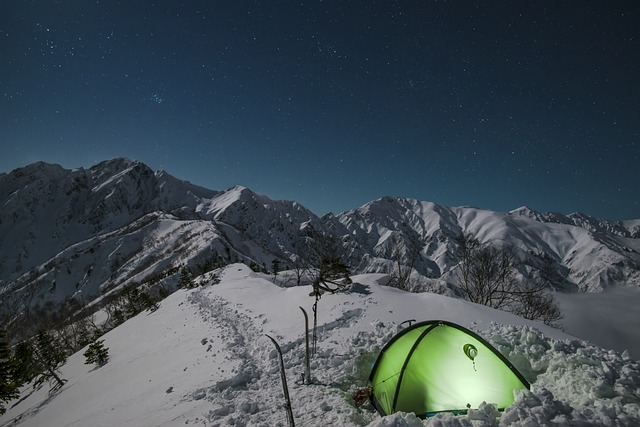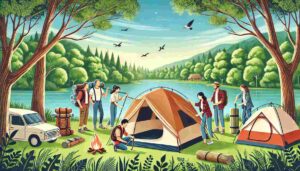Welcome to the ultimate guide on how to stay warm in a tent without electricity! Camping is an incredible way to connect with nature, but when the temperature drops, it can be a challenge to keep those shivers at bay. No need for tent electric heaters or power-hungry gadgets here; I’ll explore natural and ingenious methods to stay toasty throughout the night.
Staying warm in a tent without electricity is not only possible but also an enjoyable part of the camping experience. The best way to stay warm in a tent without electricity involves a combination of smart gear choices and creative solutions. Start by selecting the right tent and location, ensuring it’s insulated and protected from wind and water. Invest in high-quality sleeping gear, such as a warm sleeping bag and thermal sleeping pad, to create a cozy sleeping environment. Dress in layers, pre-heat your sleeping bag and utilize DIY insulation hacks like lining your tent with blankets or using reflective windshield shades.
Keep reading the detailed step-by-step guide below!
Choose the Right Tent and Location
When it comes to staying warm in a tent without electricity, choosing the right tent and location sets the foundation for a cozy camping experience. Let’s explore some key considerations to keep you snug as a bug in your tent:
- Insulated Four-Season Tent: Opt for a tent specifically designed for four seasons, as these tents are built to handle various weather conditions, including cold temperatures. Look for tents with double walls, as they provide better insulation by trapping a layer of air between the walls. This extra layer helps to retain heat and keeps cold drafts at bay.
- Rainfly and Vents: Ensure your tent comes with a rainfly, which is a waterproof cover that goes over the tent. Not only does the rainfly protect you from rain, but it also adds an extra layer of insulation and helps retain heat. Additionally, choose a tent with well-placed vents that can be opened or closed. Vents are essential for controlling humidity and condensation, preventing your tent’s interior from becoming damp and chilly.
- Size and Space: Consider the number of campers and gear you’ll have inside the tent. A smaller tent with less unused space will be easier to heat, as there’s less air to warm up. However, ensure it’s still spacious enough for your comfort.
- Location, Location, Location: Where you pitch your tent can significantly impact your warmth during the night.
- Avoid Windy Spots: Choose a sheltered location that is protected from strong winds. Winds can quickly strip away body heat and make the tent feel colder than the outside temperature.
- Elevation Matters: Camping on higher ground might be colder, especially on clear nights. Cold air sinks to lower areas, so look for slightly elevated spots that are still protected from the wind.
- Stay Away from Water: Avoid setting up your tent near bodies of water or low-lying areas. These areas tend to be colder and more prone to condensation, making the interior of your tent damp and chilly.
- Orientation: Position your tent so that the entrance is facing away from the prevailing wind. This way, when you open the door, cold air won’t rush directly into the sleeping area.
Now that you’ve got your shelter sorted, let’s move on to preparing your cozy sleeping gear!
Invest in Quality Sleeping Gear
When it comes to staying warm in a tent without electricity, investing in high-quality sleeping gear is crucial. Your sleeping bag and sleeping pad play a significant role in keeping you cozy throughout the night. Let’s dive into the must-haves for your sleeping setup:
- Warm Sleeping Bag: The heart of your camping comfort lies in your sleeping bag. Look for a high-quality, cold-weather sleeping bag designed to keep you warm in low temperatures. Consider these features:
- Temperature Rating: Choose a sleeping bag with a temperature rating lower than the expected nighttime temperatures. For example, if you expect the temperature to drop to 20°F (-6°C), opt for a bag rated for 15°F (-9°C) or even lower. This ensures you have a buffer against unexpected chills.
- Insulation Type: Sleeping bags come with either down or synthetic insulation. Down is excellent for providing an exceptional warmth-to-weight ratio, while synthetic insulation performs better when wet. Choose the one that suits your camping conditions and preferences.
- Mummy Design: Mummy-style sleeping bags have a snug fit that reduces the amount of air space inside, helping you retain more body heat.
- Thermal Sleeping Pad: Preventing the cold ground from sapping your body heat is equally important. Invest in a high-quality, insulated sleeping pad to create a barrier between you and the chilly earth.
- R-Value: Check the R-value of the sleeping pad. The higher the R-value, the better the insulation. For colder conditions, aim for a pad with an R-value of 3 or higher.
- Self-Inflating or Foam Pads: Self-inflating pads offer convenience and added comfort, while foam pads are durable and great for colder conditions.
- Sleeping Bag Liner: If you’re looking for an extra layer of insulation or if your sleeping bag’s temperature rating is slightly higher than the expected night temperature, consider using a sleeping bag liner. Liners can add a few degrees of warmth to your sleeping bag and are easy to wash after use.
Remember, investing in quality sleeping gear isn’t just about comfort—it’s also about safety. Staying warm during chilly nights will help you get a good night’s sleep, keeping you alert and energized for your outdoor adventures the next day.
Let’s layer up and explore how to keep warm with the right clothing.
Layer Up for Maximum Warmth
Dressing in layers is a fantastic way to stay warm and regulate your body temperature while camping in a tent without electricity. Let’s explore the art of layering for maximum warmth:
- Base Layer Clothing:
- Opt for moisture-wicking thermal base layers made of materials like merino wool or synthetic fabrics. These layers will keep you dry by wicking away sweat and preventing moisture from cooling your body.
- Middle Layer:
- Choose a fleece or down jacket as your middle layer. These materials provide excellent insulation and trap warm air close to your body, keeping you toasty throughout the night.
- Outer Layer:
- Don a waterproof and wind-resistant jacket as your outermost layer. This will protect you from any rain or cold winds that may find their way into your camping setup.
- Insulating Accessories:
- Don’t forget to cover your extremities! Wear warm socks, preferably made of wool or synthetic materials. Cold feet can be incredibly uncomfortable when trying to sleep.
- Thermal gloves and a beanie or a hat can also help retain heat and keep you comfortable during the night.
You can always adjust your layers based on the temperature. If it’s particularly cold, add an extra layer, and if it gets warmer, you can remove a layer to avoid overheating.
Pro Tip: Before you crawl into your sleeping bag, make sure your body is already warm. Do some light exercises, like jumping jacks or brisk walking, to raise your core temperature. This will help you feel cozy from the moment you slip into your sleeping bag.
With the right layers, you’ll be ready to tackle even the chilliest of nights and wake up refreshed and ready for more outdoor adventures.
Now, let’s explore some ingenious tricks to pre-heat your sleeping bag and maximize its warmth.
Pre-Heat Your Sleeping Bag
Pre-heating your sleeping bag is a clever and effective way to ensure a warm and cozy sleeping experience. Let’s explore two fantastic techniques to make your sleeping bag feel like a snug cocoon:
- The Hot Water Bottle Trick:
- Before heading to bed, boil some water and carefully pour it into a sturdy, leak-proof water bottle.
- Seal the bottle tightly and place it at the foot of your sleeping bag.
- The warm water will create a toasty pocket of heat inside your bag, keeping your feet and lower body comfortably warm throughout the night.
- Warm Up Your Bag with Body Heat:
- Before you hop into your sleeping bag, give it a bit of TLC. Vigorously shake and knead your sleeping bag to fluff up the insulation.
- Then, slide into your bag and use your body heat to warm up the interior. Move around a bit and wriggle into a comfortable position, allowing your body heat to distribute evenly.
Pro Tip: If you have extra clothing, like a jacket or an extra layer, place it inside your sleeping bag before you go to sleep. This adds another layer of insulation and enhances the warmth.
Next, I’ll explore some fantastic DIY insulation hacks to further amp up your tent’s coziness.
DIY Insulation Hacks
The joy of creative DIY hacks! Let’s explore some ingenious ways to insulate your tent and keep the cold at bay:
- Blanket Fort:
- Line the interior walls of your tent with thick blankets or emergency foil blankets (space blankets).
- These blankets act as an additional layer of insulation, trapping warm air inside the tent and preventing cold drafts from seeping in.
- Reflective Windshield Shades:
- Grab a couple of reflective car windshield shades and use them to cover the outside of your tent.
- The reflective material will bounce back your body heat and reduce heat loss through the tent walls.
- DIY Door Flap:
- Cut a piece of thick fabric or an old blanket to size, making it slightly larger than your tent’s entrance.
- Attach the fabric to the inside of the tent’s entrance using clips or strong adhesive tape to create a flap.
- This makeshift door flap will act as an extra barrier against cold air and wind when you enter or exit the tent, helping to maintain the warmth inside.
- Campfire Stones:
- If you have access to rocks or stones, place them near the campfire to heat them up.
- Before you head to bed, carefully move the hot stones into your tent. Make sure they are not scorching hot, but still warm to the touch.
- Arrange the stones around the sleeping area to radiate gentle heat, providing natural warmth throughout the night.
- DIY Floor Insulation:
- Place a layer of foam or cardboard under your sleeping pad to add an extra buffer between you and the cold ground.
- You can also use thick blankets or an old yoga mat to provide insulation.
Remember, these DIY hacks can enhance the coziness of your tent, but always prioritize safety. Ensure that any DIY modifications you make to your tent are fire-resistant and don’t pose any hazards.
With these ingenious DIY insulation tricks, you’ll transform your tent into a cozy sanctuary that you’ll be reluctant to leave when morning comes. But, before I wrap up, let’s explore the warmth of companionship with the buddy system.
Embrace the Buddy System
Embracing the buddy system not only adds to the fun and camaraderie of camping but also helps to share and generate extra warmth during chilly nights. Here’s how you and your camping companions can stay cozy together:
- Snuggle Up:
- If you’re camping with a partner or a friend, snuggling up together is a fantastic way to share body heat and stay warm.
- Sleeping side by side or even huddling close can create a warm and intimate space inside the sleeping bags.
- Group Camping:
- If you’re camping with a larger group, consider arranging your sleeping bags close to each other in a circle or a cluster.
- The collective body heat generated by the group will create a warm microclimate within the camping area.
- Share Extra Blankets:
- Encourage everyone to bring extra blankets, quilts, or sleeping bag liners to share with others if needed.
- The more insulation you have inside the tents, the cozier it will be for everyone.
- Cook and Dine Together:
- Gather around the campfire or the camping stove and cook and dine together.
- The heat from cooking and the shared mealtime warmth will keep everyone comfortable before bedtime.
- Cozy Campfire Chat:
- Spend some quality time sitting around the campfire, sharing stories, and enjoying each other’s company.
- The warmth of the fire and the joy of togetherness will make for delightful memories.
Remember to be considerate of each other’s space and preferences. While some campers may appreciate the warmth of the buddy system, others might prefer their own space. Always communicate and respect everyone’s comfort levels.
Keep Active Before Bedtime
You got it! Staying active before bedtime is an excellent way to warm up your body and ensure a cozy night’s sleep in your tent. Here are 6 fun and light activities to keep you warm before you hit the hay:
- Campfire Fun:
- Gather around the campfire with your camping buddies and engage in some fun activities.
- Roast marshmallows, tell stories, sing songs, or play campfire games. The excitement and laughter will raise your body temperature and keep you warm.
- Night Stroll:
- Take a short walk around the camping area. A gentle stroll can help increase blood circulation and warm up your body.
- Enjoy the starry night sky and the peaceful ambiance of nature.
- Stretching Exercises:
- Perform some light stretching exercises like yoga or simple stretches.
- Stretching improves blood flow and flexibility, and it’s a great way to relax your muscles before bedtime.
- Campfire Workout:
- Use the campsite as your personal gym! Do some bodyweight exercises like squats, lunges, or push-ups near the campfire.
- It’s an excellent way to warm up and stay active while enjoying the outdoors.
- Nighttime Photography:
- Capture the beauty of the night sky with some nighttime photography.
- Setting up your camera and moving around to find the perfect shot will help keep you warm.
- Glow Stick Dance Party:
- Spice up the night with a glow stick dance party! Put on some music and dance around with glow sticks to create a fun and warm atmosphere.
The goal is to stay active but not exhaust yourself before bedtime. These light and enjoyable activities will raise your body temperature without making you too sweaty or uncomfortable when it’s time to hit the sack.
Hot Meals and Drinks
Hot meals and drinks are the ultimate comforts on chilly camping nights without electricity. Not only do they warm you up from the inside out, but they also add to the delightful camping experience. Let’s explore some delicious hot meal and drink ideas:
Hot Meals:
- Hearty Campfire Stew: Prepare a flavorful stew with your favorite vegetables, meat (if you’re not a vegetarian), and some tasty broth. Let it simmer over the campfire in a cast-iron pot or a sturdy Dutch oven until everything is tender and full of flavor.
- One-Pot Pasta: Cook some pasta with a savory sauce, vegetables, and spices in a single pot. It’s a simple, satisfying, and quick-to-make meal that warms your heart.
- Chili Con Carne: This spicy classic is perfect for cold camping nights. Cook ground beef, beans, tomatoes, and spices together in a pot, and let it simmer until the flavors meld.
- Hot Soup: Prepare a nourishing soup with vegetables, lentils, or barley. It’s an easy and healthy way to warm up and stay energized during your camping adventures.
Hot Drinks:
- Hot Cocoa: Nothing beats a cup of rich and creamy hot cocoa on a chilly night. Bring along some hot cocoa mix and mix it with hot water or milk for a sweet treat.
- Herbal Tea: Sip on soothing herbal tea to relax and warm up. Chamomile, peppermint, or ginger tea are excellent choices for a calming and comforting beverages.
- Spiced Apple Cider: Heat up some apple cider and add spices like cinnamon, cloves, and a dash of nutmeg for a fragrant and warming beverage.
- Hot Coffee: If you’re a coffee lover, bring along a French press or a portable coffee maker to brew your favorite cup of joe. There’s nothing like the aroma and warmth of freshly brewed coffee in the morning or evening.
Pro Tip: To keep your hot meals and drinks warm, use insulated containers or thermoses. They will retain the heat and allow you to enjoy hot food and beverages even after they’ve been prepared.
Conclusion
In conclusion, staying warm in a tent without electricity is essential for a comfortable and enjoyable camping experience. To summarize follow these 9 steps to staying warm in a tent without electricity during chilly nights:
- Choose the Right Tent: Opt for a well-insulated four-season tent with a rainfly and vents to trap heat and block cold drafts.
- Select a Sheltered Location: Set up your tent away from strong winds, on higher ground, and avoid areas near water or low-lying spots.
- Invest in Quality Sleeping Gear: Get a warm sleeping bag rated for lower temperatures than expected, and use a thermal sleeping pad for insulation from the cold ground.
- Layer Up: Wear moisture-wicking thermal base layers, a fleece or down jacket for added warmth, and a waterproof and wind-resistant outer layer.
- Pre-Heat Your Sleeping Bag: Use a hot water bottle or body heat to warm up your sleeping bag before crawling in.
- DIY Insulation Hacks: Line the tent walls with blankets, use reflective windshield shades, and create a DIY door flap for extra insulation.
- Embrace the Buddy System: Snuggle up with a partner or group together for shared body heat.
- Stay Active Before Bedtime: Engage in light physical activities or enjoy the campfire to raise your core body temperature.
- Hot Meals and Drinks: Warm up from the inside out with hearty meals and hot beverages like soups, stews, hot cocoa, and herbal teas.
Now, armed with this guide, you’ll be well-prepared to face the cold and have a warm and cozy time in your tent without electricity. Embrace the beauty of nature, relish in the warmth of your cozy tent, and create lasting memories that will warm your heart for years to come. Happy camping! 🌲🏕️🔥










